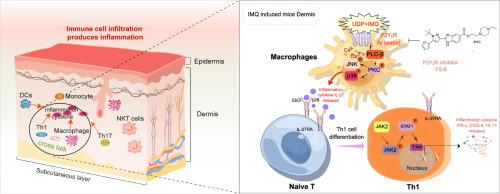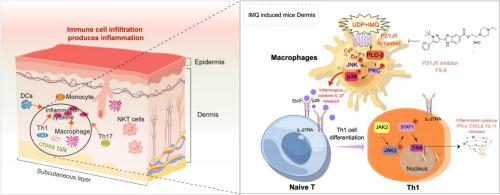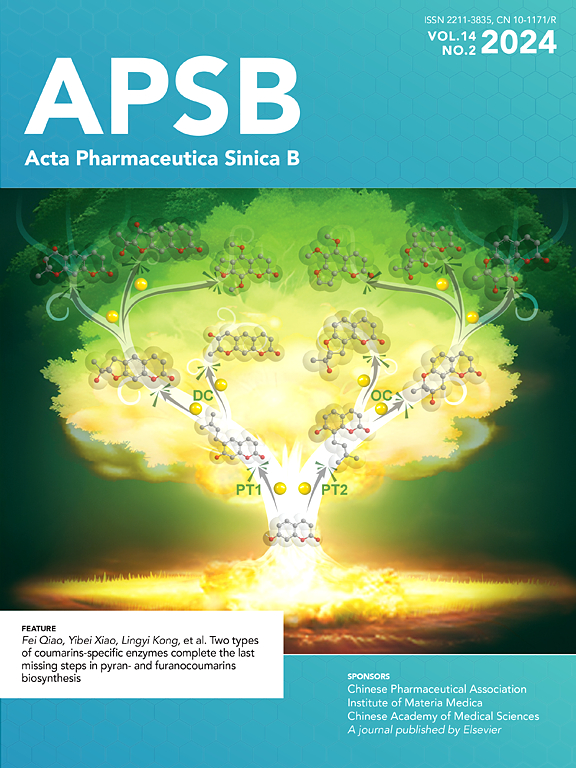巨噬细胞 P2Y6R 激活通过 IL-27 介导的 Th1 反应加剧银屑病炎症
IF 14.7
1区 医学
Q1 PHARMACOLOGY & PHARMACY
引用次数: 0
摘要
嘌呤能信号在银屑病发病过程中对免疫炎症反应的调节起着决定性作用,但其调节机制尚不清楚。在本研究中,作为嘌呤受体的一员,主要分布于巨噬细胞的 P2YR 在银屑病患者的皮损中明显高表达。在本研究中,巨噬细胞条件性敲除 P2YR 的咪喹莫特处理小鼠的银屑病严重程度得到缓解,而细胞聊天算法显示巨噬细胞 P2YR 与 IL-27 介导的 Th1 细胞之间存在相关性。从机理上讲,P2YR能增强PLC/p-PKC/MAPK的激活,从而诱导IL-27的释放,进而调节Th1细胞的分化,导致银屑病的红斑和鳞屑。有趣的是,我们开发了一种新型 P2YR 抑制剂 FS-6,它与 P2YR 的 ARG266 侧链结合,针对 P2YR 发挥了显著的抗银屑病作用。我们的研究深入揭示了 P2YR 在银屑病发病机制中的作用,并表明它有可能成为开发治疗干预措施的靶点。新型 P2YR 抑制剂 FS-6 可作为抗银屑病候选药物应用于临床。本文章由计算机程序翻译,如有差异,请以英文原文为准。


Macrophage P2Y6R activation aggravates psoriatic inflammation through IL-27-mediated Th1 responses
Purinergic signaling plays a causal role in the modulation of immune inflammatory response in the course of psoriasis, but its regulatory mechanism remains unclear. As a member of purinoceptors, P2Y6R mainly distributed in macrophages was significantly up-expressed in skin lesions from patients with psoriasis in the present study. Here, the severity of psoriasis was alleviated in imiquimod-treated mice with macrophages conditional knockout of P2Y6R, while the cell-chat algorithm showed there was a correlation between macrophage P2Y6R and Th1 cells mediated by IL-27. Mechanistically, P2Y6R enhanced PLCβ/p-PKC/MAPK activation to induce IL-27 release dependently, which subsequently regulated the differentiation of Th1 cells, leading to erythematous and scaly plaques of psoriasis. Interestingly, we developed a novel P2Y6R inhibitor FS-6, which bonds with the ARG266 side chain of P2Y6R, exhibited remarkable anti-psoriasis effects targeting P2Y6R. Our study provides insights into the role of P2Y6R in the pathogenesis of psoriasis and suggests its potential as a target for the development of therapeutic interventions. A novel P2Y6R inhibitor FS-6 could be developed as an anti-psoriasis drug candidate for the clinic.
求助全文
通过发布文献求助,成功后即可免费获取论文全文。
去求助
来源期刊

Acta Pharmaceutica Sinica. B
Pharmacology, Toxicology and Pharmaceutics-General Pharmacology, Toxicology and Pharmaceutics
CiteScore
22.40
自引率
5.50%
发文量
1051
审稿时长
19 weeks
期刊介绍:
The Journal of the Institute of Materia Medica, Chinese Academy of Medical Sciences, and the Chinese Pharmaceutical Association oversees the peer review process for Acta Pharmaceutica Sinica. B (APSB).
Published monthly in English, APSB is dedicated to disseminating significant original research articles, rapid communications, and high-quality reviews that highlight recent advances across various pharmaceutical sciences domains. These encompass pharmacology, pharmaceutics, medicinal chemistry, natural products, pharmacognosy, pharmaceutical analysis, and pharmacokinetics.
A part of the Acta Pharmaceutica Sinica series, established in 1953 and indexed in prominent databases like Chemical Abstracts, Index Medicus, SciFinder Scholar, Biological Abstracts, International Pharmaceutical Abstracts, Cambridge Scientific Abstracts, and Current Bibliography on Science and Technology, APSB is sponsored by the Institute of Materia Medica, Chinese Academy of Medical Sciences, and the Chinese Pharmaceutical Association. Its production and hosting are facilitated by Elsevier B.V. This collaborative effort ensures APSB's commitment to delivering valuable contributions to the pharmaceutical sciences community.
 求助内容:
求助内容: 应助结果提醒方式:
应助结果提醒方式:


